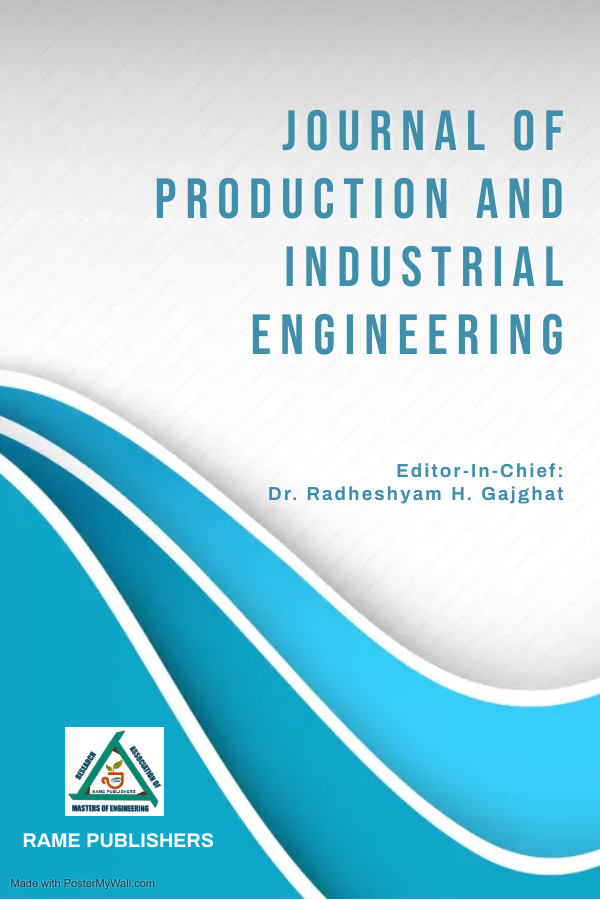Development of Paver Block by Using Plastic Waste
Trishanku Choudhary, Dhirajkumar Thakur, Pushkar Umap, Nihal Kolhe, Vishal Gajghate
Journal of Production and Industrial Engineering
Volume 4: Issue 2, September 2023, pp 98-100
Author's Information
Vishal Gajghate1
Corresponding Author
1G H Raisoni University, Saikheda, M.P., India
vishal.gajghate@raisoni.net
Trishanku Choudhary2, Dhirajkumar Thakur2, Pushkar Umap2, Nihal Kolhe2
2G H Raisoni University, Saikheda, M.P., India
Abstract:
The aim of the rapid industrialization and urbanization in the country leads lot of infrastructure development. This process leads to several problems like shortage of construction materials, increased productivity of wastes and other products. This paper deals with the reuse of waste plastics as partial replacement of coarse aggregate in M25 concrete is used for most constructional works. Waste plastics were incrementally added in 0%, 5%, 10%, 15% and 20% to replace the same amount of aggregate. Tests were conducted on coarse aggregates, fine aggregates, cement and waste plastics to determine their physical properties. Paver Blocks and Solid blocks of size 200mm X150mmX60mm and 2oommX100mmX65mm were casted and tested for 7, 14 and 28 days strength. The result shows that the compressive strength of M25 Concrete with waste plastic.Index Terms:
Plastic Waste, Fine Aggregate, Cement, Paver BlockREFERENCES
- Koli Nishikant, Aiwale Nachiket, Inamdar Avadhut, Abhishek Sanga “Manufacturing of concrete paving block by using waste glass material”, International Journal of Scientific and Research Publications Volume 6, issue 6, 61, June 2016.
Crossref - Kevin Klarens, Michael Indranata, Luthfi Al Jamali, and Djwantoro Hardjito, “The use of bottom ash for replacing fine aggregate in concrete paving blocks”, Matec Web of conferences 138, 01005, 2017.
Crossref - Radhikesh P. Nanda, Amiya K. Das, Moharana.n.c, “ Stone crusher dust as a fine aggregate in concrete for paving blocks”, International Journal of Civil and Structural Engineering , Volume 1, No 3, 2010.
Crossref - Muhammad Fauzi Mohd. Zain, Sudharshan Naidu Raman, Azimin Samsul Tazilan, Abdul Halim Ismail, Mazlan Tahir dan Zulhairuse Md Darus, “Penggantian sebahagian pasir dengan debu kuari ke atas ciri konkrit prestasi tinggi baru”, Jurnal Kejuruteraan 17 page 3-12, 2005.
Crossref - Ashish Patanwadia, Hardik Solanki , “Effect of replacement of natural sand by quarry dust on mechanical Properties”, Volume5, issue 4, International Journal of engineering technology science and research, April 2018.
Crossref - Anzar Hamid Mir, March, “Improved concrete properties using quarry dust as replacement for natural Sand”, International Journal of engineering research and development, Volume 11, issue 03, pp.46-52, 2015.
Crossref - B. Shanmugavalli, “Reuse of plastic waste in paver blocks”, International Research Journal of Engineering and Technology (irjet), Vol. 6 issue 02, February 2017.
Crossref - Uroosa Iqbal, Muhammad Akram, Abdullah Saand, “Soft drink tins as fibre reinforcement in concrete”, Proceedings of Ampe, 14-15, 2015.
Crossref - M. Achitra, R. Ambika Rajasree, R. Vijayalakshmi Pandit, V.Saranya, “Recycled Plastic and Coconut fibre used in concrete paver block”, Volume 8 issue no.4 Research Article, 2018.
Crossref - Naushad Khan, Ruchi Chandrakar, “An experimental study on uses of quarry dust to replace sand in concrete”, International research journal of engineering and technology Volume: 04 issue: 11, Nov 2017. AUTHORS PROFILE Nor Baizura Hamid is a Bachelor holder in Civil.
Crossref
To view full paper, Download here
To View Full Paper
For authors
Author's guidelines Publication Ethics Publication Policies Artical Processing Charges Call for paper Frequently Asked Questions(FAQS) View All Volumes and IssuesPublishing with




